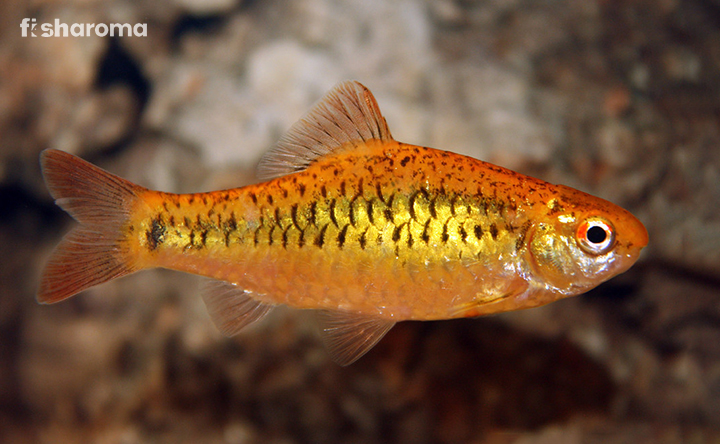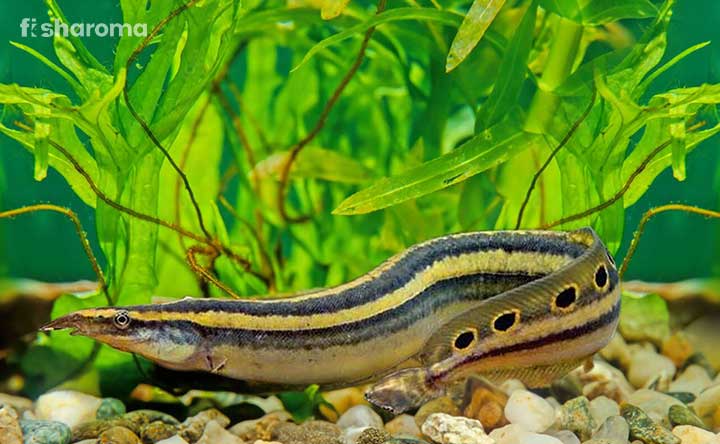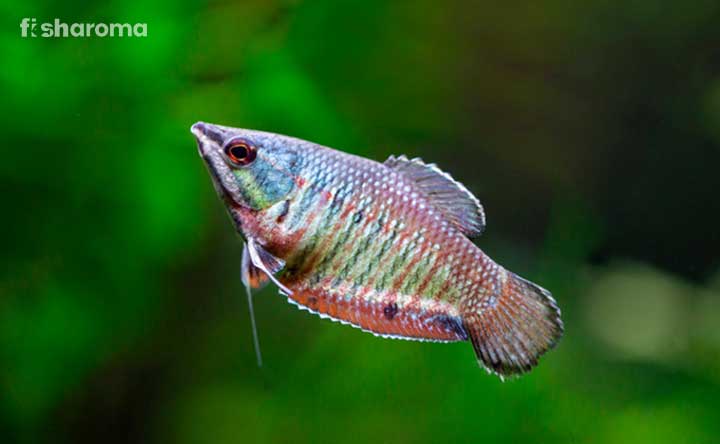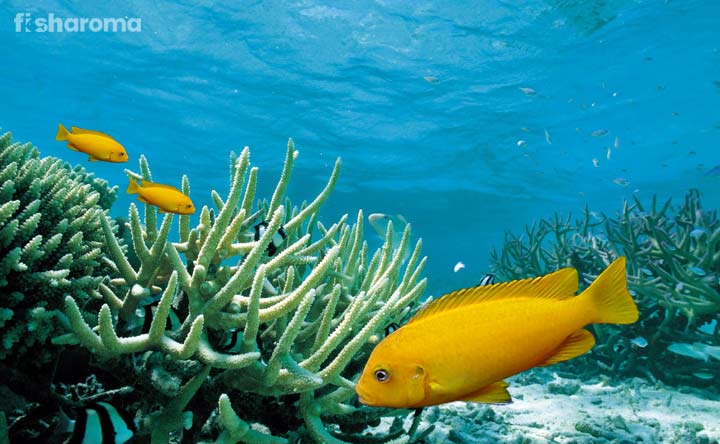Gold Barb Care Guide: A Thorough Maintenance of the species

Gold Barb is an extremely peaceful and ostentatious fish, that dwells in a freshwater community tank. This fish bags innumerable names, among which, notable to mention are Chinese Barb, Green Barb and Chinese half-striped Barb. These Gold Barbs are shoaling fishes and they will surely keep you engrossed in your aquarium.
The principal reason for them to be popular among aquarists is that they are very easy to take care of. Moreover, a newbie fish keeper will certainly prefer these fishes, as they are hardy in nature and don’t need any rocket science rule to look after them.
This article will help you to know every nook and corner of their care, thus providing you with the intense knowledge required for keeping these Barbs. Let us take you through their diet to breeding, as you gradually enjoy being a pet parent!
Key Specifications of Gold Barb
Before we take you through the intricate details of these Gold Barbs, let us discuss a few key specifications of these fishes in short.
| Scientific Name | Barbodes semifasciolatus |
| Origin | Red River basin of the Hong River, through Asia from Southwest China to Vietnam |
| Lifespan | 5-7 years |
| Colours | Golden with black spots |
| Temperament | Peaceful |
| Size | Up to 3 inches |
| Diet | Omnivorous |
| Family | Cyprinidae |
| Compatibility | Peaceful fishes |
| Tank Size | 20 Gallons |
| Care Level | Easy |
Overview
Gold Barbs are likely to brighten up your aquarium in the most colourful way through their sparkling gold colour and amazing shoaling nature. Generally, these fishes are olive-green in colour, however, they have been selectively captive-bred, which has given them a vibrant gold colouration. Their name has been derived from their bright golden hue.
These fishes are at risk in the wild, because this human-created shiny colouring makes it easy for predators to target them. Sadly, their numbers are decreasing in the wild as their natural habitat is at stake.
Belonging from Cyprinidae family, these fishes are scientifically known as Barbodes semifasciolatus. The green-coloured specimens of the wild are known by the scientific name of Puntius semifasciolatus. However, they are rare as the gold ones have gained recent importance in the aquarium trade. The captive alternative form of this Gold Barb is also known as Schuberti Barb.
Origin and Habitat of Gold Barb
Native to the Red River basin of Hong River, these Gold Barbs are found in large areas through Asia from Southwest China to Vietnam. Their living area also extends far from Southern China to Fujian and further towards the north. It has been known that these fishes have been significantly bred in the areas of Hong Kong, Taiwan and Hawaii.
Their natural habitat is the Red River Basin and the associated tributaries. They prefer freshwater and swim gently in free-flowing streams, where they get a decent water force. These fishes generally inhabit at a depth of almost 5 meters in water. Gold Barbs prefer to swim in open water, where they would get dense vegetation. These barbs prefer shallows where they can get a good amount of light.
Appearance of Gold Barb
The Gold Barb has short barbels that are situated in the corner of their mouth. There are black spots on the lateral lines of the body, which sometimes appear as vertical bars. If the breed is well maintained, a red colouring might occur on the fins. The most amazing feature of their appearance is that their mouth is on the head which angles in the backward position.
Owing to the difference in their looks, the green-coloured and the gold-coloured Gold Barbs were considered to be different. Presently, it has been confirmed that these are the same species.
Colour
As their name suggests, these Gold Barbs are not exactly gold-coloured, while in the wild. Nevertheless, in aquariums, these fishes are fully gold, with only a few blotches of dark black colour along the lateral side and upper portion of their body.
The olive green-coloured Gold Barb is generally observed in natural habitats, which has completely changed in captive breeding. A few selective captive-bred specimens have been introduced in the home aquarium, which includes a tricolour variation (black, pink and orange) along with an albino variant (pink coloured or with no black markings). That apart, the females are a little blunt in colouration and stand to be larger in size than the males, whereas the belly of males become reddish to orangish during spawning season.
Size
In adulthood, these fishes reach a length of 3 inches. The females look a bit large, as they have a belly of rounded shape. Moreover, they tend to look faded in colour. The males might develop a red belly, while mating.
Behaviour of Gold Barb
These peaceful natured fish needs to be kept among shoaling species. Their behaviour needs to match with the other fishes they are kept with. Moreover, they generally prefer to dwell with other peaceful fishes that do not tend to prey on them. However, these Gold Barbs are extremely clever in communication and they technically nip other fishes’ fins to interact with them. This is the reason behind not keeping any long-finned fishes with them.
Though they are shoaling, still they prefer to live in a species-specific tank, within a group of 5. They feel safe while swimming with their own family members. Keeping them in a group helps to reduce their stress level. With a larger group, they feel comfortable and confident enough to swim gracefully.
Keeping in mind that Gold Barbs explore the lower and middle levels of the tank, you need to leave plenty of space for them to move freely. The only time they put their head up is when they could sense food. Not only do they nip others’ fins but also try to prick live plants within the aquarium. So it is best to avoid an overplanted tank.
Lifespan of Gold Barb
While in captivity, these fishes reach a lifespan of 5-7 years.
Diet of Gold Barb
Gold Barbs are omnivorous fishes, which says they prefer to eat both plant-based and meaty foods. You can surely design their diet accordingly. Since they prefer an omnivorous diet, there is a range of various nutrients that can be fed to them, so that they remain strong enough.
You can feed them with live foods which include bloodworms, brine shrimps and daphnia. One must need to strictly avoid giving them the same consistent food like dried pellets and flakes. Add an array of fresh vegetables that would act as supplements for them. The different range of foods that you can feed your pet Goldie are listed below:
- Micro worms
- Grindal worms
- Moina
- Detritus
- Larvae
- Insects
- Algae wafers and
- Frozen and dried worms
As we say of dried worms, you must not get elated because dried food tends to reduce their nutrition. This happens because, during manufacturing, rather the drying procedure, these pellets, flakes or even worms lose their nutritional value.
It is always better to provide them with live or simply frozen foods.
Tank Requirements for Gold Barb
Following their natural habitat, the Gold Barbs prefer a replica of this freshwater environment in their aquarium. Modelling their origin would help them to stay hale and hearty as much as possible. You can surely do it! Before that, go through our guide for making sure that you don’t miss out on any important parameter.
Tank Size
As they are shoaling fishes, they prefer to dwell within groups. Moreover, they like to swim actively in the lower and middle levels, which demand a large and spacious aquarium. You can aptly put them in a 20-gallon tank.
Tank lid
Though comparatively low jumpers, they still prefer to play in the water outflow of the filter. This says they enjoy the current of the water that circulates near the filter mouth. But, sometimes they even try to be extra playful and jump out of the water to reach a higher level. This turns out to be dangerous for them.
It is always better to keep a lid on the aquarium so that these fishes will not come out of the tank. Moreover, a lid helps to resist any kind of foreign elements from getting accumulated within the tank. But yes, make sure there is no small gap within the lid and the water as jumping high might hurt them even if they strike the lid.
Substrates
These fishes live in the lower portion, so they need a soft and sustainable substrate on the tank floor. This layering helps them to be comfortable. While you put soft sand, you can avoid keeping gravels. As these fishes like to venture into the nooks and corners of any object they find within the tank, gravels might hurt them. They will get scratches on soft fins through the gravel.
Ornaments
Gold Barbs like to wander through rocky caves, driftwood and rock crevices. For them to hide, you can surely add all these ornaments in their tank, provided their swimming space is not compromised.
Filter
For these Goldies, you better choose Hang On Back Filters as they have twofold advantages. Firstly they are economically viable and moreover, they provide current to the water in the tank. Gold Barbs like to play in this circulating water current.
These fishes can live well in normal free-flowing water within a tank. The natural force is okay for them. It is not necessary to put any air pump or filter just for the sake of creating a water current. Use the filter for proper cleanliness.
Presence of Flora
These fishes, though like to roam around within vegetation, still don’t like any overplanted place. You can certainly keep the plantation at low. Create a foliage but keep that mainly on the upper surface as they don’t venture on the upper side much.
For decor purposes of your tank, you can put a few plants like grasses on the bottom and some long stems with leaves in the middle level. Make sure, you keep some fine-leaved artificial plants as they nip on leaves of live plants.
Lighting
You can keep a normal dim light for these fishes. With this low light, the beauty of the fish is not as much visible, though vibrancy in lighting is also not possible. This might reflect a metallic look on the colour of the fish.
Cleaning Method
The Barbs do not like murky or dirty water, for which the role of cleaning is very important. Firstly, a filter creates enough oxygen, which is the primary need of the fish. That apart, if there is an accumulation of algae, you can use an algae scraper or even for some specific algae, use bleach with water in a ratio of 1:20.
Cleaning keeps your fishes healthy and residuals must be removed religiously to avoid any disease to the fish.
Water Requirement for Gold Barb
Water is an important aspect for fishes and hence, it is imperative to keep all the parameters at par.
Temperature
As these fishes like comparatively colder water, you can adjust the temperature to 21-25 Degrees Celsius. In the original habitat of subtropical regions, there is a fluctuation in water temperature. So you can keep that variation without any heating. They can tolerate the temperature even if it goes down to 15 Degrees Celsius.
pH Level
Maintain a pH level of 6.0-6.8 for these fishes.
Hardness
The general water hardness must remain around 8 dGH.
Replacement Procedure
The replacement of water in a fish tank is of pivotal importance. In the case of Gold Barbs, you can change the water, rather renew it once a week. But make sure, you only change 20% of the whole water volume at a time, every alternate week. If you want to clean the tank water, clean on a regular basis, then you have to change 10% of the water every week.
To keep the water healthy, it is always recommended that you use a water testing kit. It will help you to completely keep track of the issues in water parameters. Poor water leads to the development of pathogens.
Compatibility of Gold Barb
These fishes are peaceful in nature, though the males somehow become semi-aggressive during the spawning session. You can group them with their own species or other fishes that are in no way destructive or disturbing to the Barbs. The potential companions and unsuitable tank mates of these fishes include the following.
Suitable Tank Mates
There are a plethora of tank mates that you can keep with your barb. They need to be paired with any fast-moving fish. Being an excellent community-tank fish, the other similar mates are
- Danios
- Dwarf Gourami
- Cory Catfish
- Zebra Loaches
- Red Tail Shark
- Rainbow Shark
Unsuitable Tank Mates
You can not match the company of these fishes with any other aggressive fishes. It is preferable not to keep them with a few large finned fishes.
- Bettas
- Sailfin Mollies
- Neon Tetra
- Angelfish
- Female Guppies (as they have large fins)
Breeding of Gold Barb
To breed this category of Barbs, you need to keep the tank purely clean and free of any destructive condition.
The breeding process demands many a thing that is highly needed for the proper spawning of these fishes. The temperature must be adjusted to a little high, like at least 25-26 Degrees Celsius, for a specific number of days just before spawning. keep the pH level from 6 to 7 and the water condition needs to be soft.
For creating a special origin like environment, you can certainly put Java Moss and any other fine-leafed plants. You can use netting or any interlace structure for allowing the eggs to fall down. With a dim light, the females feel comfortable and they prefer to hide away and the males turn somehow aggressive during this season. As we already mentioned in the ornament section, you have to set up this fish tank in accordance with the fishes, with an abundance of hiding places. You can also use a spawning mop for the ease of the procedure.
These egg scatterers have an amazing feature where they can spawn in groups. For this purpose, there is a need for one female for one male.
Once you plan to breed them, you need to provide the fishes with protein and live foods. After getting enough nutrition, you need to put the vibrant male fish with the beautiful and chubby female in the breeding tank.
With their bright reddish-orange belly, the males circle around the female and the breeding process is gradually triggered. The most interesting fact is that, the males would nudge the females or slightly prick them towards any planted area within the aquarium. As they gently chase the females, they create the chance of mating. Once mating is completed, the female fish would release almost 200 eggs.
These fishes don’t display any emotional parental instinct. Rather, they tend to snack the fries. So, it is always advisable to remove the fries as they can happily dwell in a heavily planted aquarium. You can feed the baby fishes with any fry’s food but that should be fine in nature and infusoria. Make sure you keep the babies in a dark shaded place as they cannot tolerate much light in their newly born state.
Diseases and Treatment of Gold Barb
These fishes are not much prone to diseases, although they can catch any kind of freshwater diseases like Ich or White Spot Diseases. This can occur as pathogens develop in poor water conditions. Once you see the white salt-like spots, quarantine the fish. Consult a veterinarian for further medications.
Summary
Keeping a Gold Barb is great! All the orangish and reddish in your tank would suffice that the room has a soothing ambience.
With these schooling species, you can always watch out for a movement in your tank. Gold Barb juveniles grow really fast, so prepare yourself to be a proud Goldie parent.
Care Guides for Similar Pets
If you like reading our Care Guide and find it useful for your aquarium, then go through all our different blogs.
- Care Guide to Rosy Barb: These hardy fishes are a perfect pick for your tank. know more to keep them!
- Care Guide to Glass Catfish: Apart from their best suitable Cory catfish, we have a bunch of other names also, including Glass Catfish. Read more to know them all.
- Care Guide to Siamese Fighting Fish: These fighting fishes can survive in an artificial environment.









